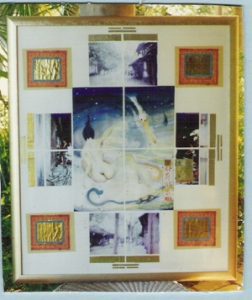But here’s the rub. To strive to create authentic art one must create as if everything in the world mattered. The counter world of art and culture should be deeply engaged with this quest. One should be in awe of each of the mysterious and magical processes of reality forming and unravelling with a similar wonderment that the ecologist has for the unique presence and power of nature.
With my recent Multicultural works, I am concerned with finding cross over points between Eastern and Western culture. I ask where the best central energies meet and collide, and how this collision can aid a deeper personalisation and humanisation process within the images. Real artistic doors must be forced open. This subject matter and themes can be and must aspire to be as wide as life itself. Manifest in its actual and potential sphere and all its fantastic possibilities.
I have been stimulated by travels and my personal interaction with China and India. I am now spurred on and trying energetically to find what might be seen as hybrid types of cultural attitudes and styles. I try and synthesise these with more holistic quests and aspirations focusing on multicultural creative fusions, that may reflect in a small but important way, those existing and anticipated future human types of desires, wishes, identities etc. These are emerging in the present revealing affective and conceptual human artistic glimpses that can suggestively move across cultural lines.
This creative Multicultural methodology is like spirited allegorical reflection moving across and between windows of houses adjoining each other on a street inhabited by people of different races. These visual reflections can absorb aesthetic presences from the most important sector from each cultural world.
Can people of a broadly western racial and cultural background actually empathise imaginatively and with deep feeling with what it might personally for example be like to be Chinese lovers on their important wedding night in China? How would these kinds of situations challenge our and their identification and their personas in the cross cultural mix? Also, how would newly arrived Chinese visitors empathise with figures at a western wedding in an opposite interaction? But it’s the racial and cultural meeting point and overlap in the middle of these meanings that is interesting within the context offered above.
My trips across China and India and living with Chinese and Indian families and relatives have helped me focus ever closer on these important new questions of finding these points of cultural cross-over. But on all sides we live in a dilemma ridden world where late modern Multiculturalism is a very fragile entity.
